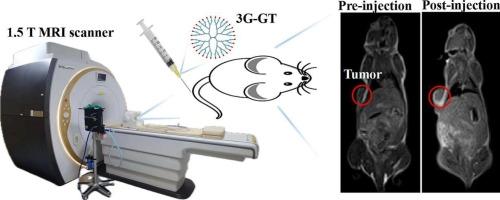Metal-free nitroxide-containing T1 magnetic resonance imaging contrast agent for invasive breast cancer diagnosis
IF 6.3
2区 化学
Q1 POLYMER SCIENCE
引用次数: 0
Abstract
Magnetic resonance imaging (MRI) is one of the most useful methods for identifying tumours at an early stage, as well as monitoring tumours, owing to its noninvasive nature. Metal-based contrast agents (CA) are commonly practised for diagnostic purposes, but have confirmed toxicity profiles (e.g., non-curable nephrogenic systemic fibrosis, neurological abnormalities, etc.). Hence, it is necessary to develop non-toxic imaging probes. An efficient strategy for conjugating nitroxides onto the dendrimers’ surface using epoxides is suggested. In this research, we report a simpler conjugation pathway of nitroxides to a series of precise dendrimer scaffold poly(amidoamine) (PAMAM). Among the radical dendrimers, the third generation 3G-GT exhibits longitudinal relaxivity (r1) of ca. 15.36 mM-1s−1 per molecule, which is exceptionally higher than metal-based CA Magnevist (3.2 mM-1s−1). 3G-GT has excellent features like superior reduction resistance and non-toxicity to living organisms. It shows attractive in vivo biodistribution as well as improved MRI contrast in breast cancer-bearing mice models, which supports the notion of the MRI CA application using the 3G-GT for early diagnosis of invasive breast cancer. Thus, the precise and stable radical dendrimers show good prospects as an alternative, metal-free MRI CA for tumour imaging.

无金属含氮氧化物T1磁共振成像造影剂在浸润性乳腺癌诊断中的应用
磁共振成像(MRI)是在早期阶段识别肿瘤以及监测肿瘤最有用的方法之一,因为它的非侵入性。金属基造影剂(CA)通常用于诊断目的,但已证实毒性(例如,不可治愈的肾源性系统性纤维化,神经异常等)。因此,开发无毒成像探针是必要的。提出了一种利用环氧化物将氮氧化物偶联到树枝状大分子表面的有效方法。在这项研究中,我们报道了一种更简单的氮氧化物与一系列精确的树突支架聚氨基胺(PAMAM)的偶联途径。在自由基树状大分子中,第三代3G-GT的纵向弛豫率(r1)为15.36 mM-1s−1 /分子,明显高于金属基ca Magnevist (3.2 mM-1s−1)。3G-GT具有优异的抗还原性和对生物体无毒等优良特性。它显示了具有吸引力的体内生物分布以及在乳腺癌小鼠模型中改进的MRI对比度,这支持了使用3G-GT进行MRI CA应用于侵袭性乳腺癌早期诊断的概念。因此,精确和稳定的自由基树状大分子作为一种替代的、无金属的肿瘤成像MRI CA具有良好的前景。
本文章由计算机程序翻译,如有差异,请以英文原文为准。
求助全文
约1分钟内获得全文
求助全文
来源期刊

European Polymer Journal
化学-高分子科学
CiteScore
9.90
自引率
10.00%
发文量
691
审稿时长
23 days
期刊介绍:
European Polymer Journal is dedicated to publishing work on fundamental and applied polymer chemistry and macromolecular materials. The journal covers all aspects of polymer synthesis, including polymerization mechanisms and chemical functional transformations, with a focus on novel polymers and the relationships between molecular structure and polymer properties. In addition, we welcome submissions on bio-based or renewable polymers, stimuli-responsive systems and polymer bio-hybrids. European Polymer Journal also publishes research on the biomedical application of polymers, including drug delivery and regenerative medicine. The main scope is covered but not limited to the following core research areas:
Polymer synthesis and functionalization
• Novel synthetic routes for polymerization, functional modification, controlled/living polymerization and precision polymers.
Stimuli-responsive polymers
• Including shape memory and self-healing polymers.
Supramolecular polymers and self-assembly
• Molecular recognition and higher order polymer structures.
Renewable and sustainable polymers
• Bio-based, biodegradable and anti-microbial polymers and polymeric bio-nanocomposites.
Polymers at interfaces and surfaces
• Chemistry and engineering of surfaces with biological relevance, including patterning, antifouling polymers and polymers for membrane applications.
Biomedical applications and nanomedicine
• Polymers for regenerative medicine, drug delivery molecular release and gene therapy
The scope of European Polymer Journal no longer includes Polymer Physics.
 求助内容:
求助内容: 应助结果提醒方式:
应助结果提醒方式:


